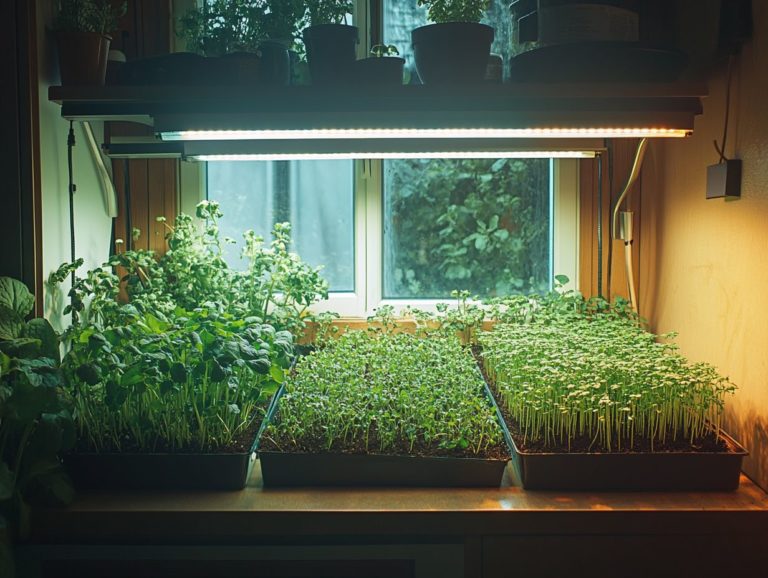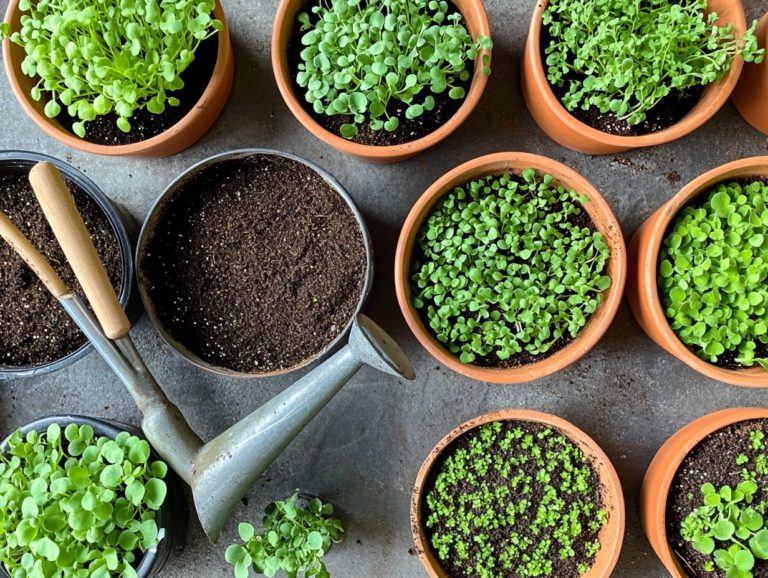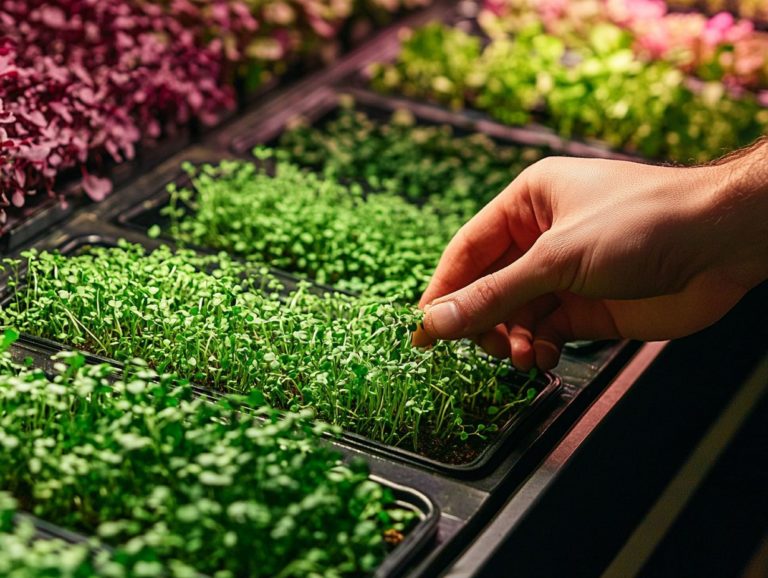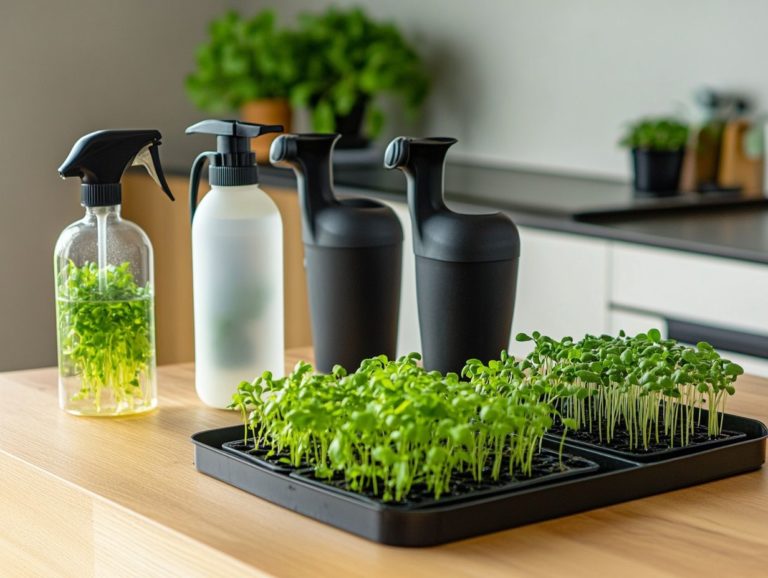5 Best Microgreen Strainers
Microgreens have truly revolutionized the culinary landscape, bursting with vibrant flavors and remarkable nutritional benefits. To fully savor these tiny powerhouses, mastering the art of proper straining is crucial.
In this guide, you ll discover the five best microgreen strainers available, ranging from sleek stainless steel mesh options to versatile cheesecloth. Dive into the unique features of each type, learn how to select the ideal one for your specific needs, and pick up essential maintenance tips.
Wave goodbye to common straining blunders and elevate your microgreen experience to new heights!
Contents
- Key Takeaways:
- 1. Stainless Steel Mesh Strainer
- 2. Fine Mesh Strainer
- 3. Nylon Mesh Strainer
- 4. Cheesecloth Strainer
- 5. Nut Milk Bag Strainer
- What Are Microgreens and Why Do They Need to Be Strained?
- Frequently Asked Questions
- What are the top 5 microgreen strainers on the market?
- What makes the SunGrow microgreen strainer stand out from the rest?
- Which microgreen strainer is best for beginners?
- Can I use the UrbanLeaf microgreen strainer for other purposes?
- Are all microgreen strainers dishwasher safe?
- What is the Botanical Interests microgreen strainer made of?
Key Takeaways:

- Stainless steel mesh strainers are durable and versatile, making them a top choice for microgreens.
- Fine mesh strainers are perfect for removing small particles while still allowing the nutrients to pass through.
- Nylon mesh strainers are great for straining larger quantities without clogging.
1. Stainless Steel Mesh Strainer
A stainless steel mesh strainer is essential for both home gardeners and cooking lovers, especially when prepping nutrient-rich microgreens for various dishes. This durable and versatile kitchen essential ensures that your microgreen seeds are efficiently strained, paving the way for optimal growth and flavor retention.
With its sturdy construction, you can trust that it won t rust or warp over time, making it a wise investment for your kitchen. Cleanup is a breeze; the smooth surface allows for easy rinsing and prevents pesky residue build-up.
Beyond these practical advantages, the fine mesh design effectively retains even the tiniest particles while allowing moisture to drain away, promoting healthy germination. Don t miss out on the chance to elevate your culinary creations microgreens can transform salads, sandwiches, or gourmet dishes, offering vibrant color and concentrated flavors that are sure to impress any palate!
2. Fine Mesh Strainer
A fine mesh strainer is an essential tool for home gardeners cultivating microgreens. It effortlessly facilitates the washing and separation of tiny seeds and sprouts from their growing medium, ensuring your harvest is pristine.
By efficiently filtering out impurities like soil particles, sand, and other debris, this tool takes your microgreens to the next level! It s not just about looks; it s essential for maintaining the nutritional integrity of varieties such as kale, radish, and basil.
When you rinse your microgreens thoroughly with a fine mesh strainer, you guarantee that these nutrient-dense young plants are free from harmful residues. The outcome? A vibrant, flavorful, and healthful enhancement to your salads, sandwiches, and garnishes that truly maximizes the benefits of your garden s bounty!
3. Nylon Mesh Strainer
Nylon mesh strainers are becoming a go-to for urban farming enthusiasts like you, thanks to their lightweight design and user-friendly nature. They’re perfect for rinsing and draining microgreens without harming those delicate sprouts.
Their versatility shines as they work seamlessly with various growing media, whether you’re using soil or hydroponic systems. This ensures your plants stay healthy throughout the cultivation process.
The smooth surface of nylon mesh makes cleaning effortless, which is crucial for maintaining hygiene and preventing pesky mold or bacteria from taking hold. By integrating nylon mesh strainers into your gardening routine, you re embracing sustainable practices.
These durable tools promote efficient water usage and help reduce waste. As a result, they not only boost your microgreen yield but also contribute positively to a more eco-friendly approach to urban agriculture.
In conclusion, choosing the right microgreen strainer is essential for maximizing the potential of your culinary creations. Whether you opt for stainless steel, fine mesh, or nylon, each type brings unique advantages to your kitchen. To ensure you’re using the best methods, check out these 5 best practices for harvesting microgreens. Elevate your cooking and enjoy the vibrant flavors of microgreens today!
4. Cheesecloth Strainer
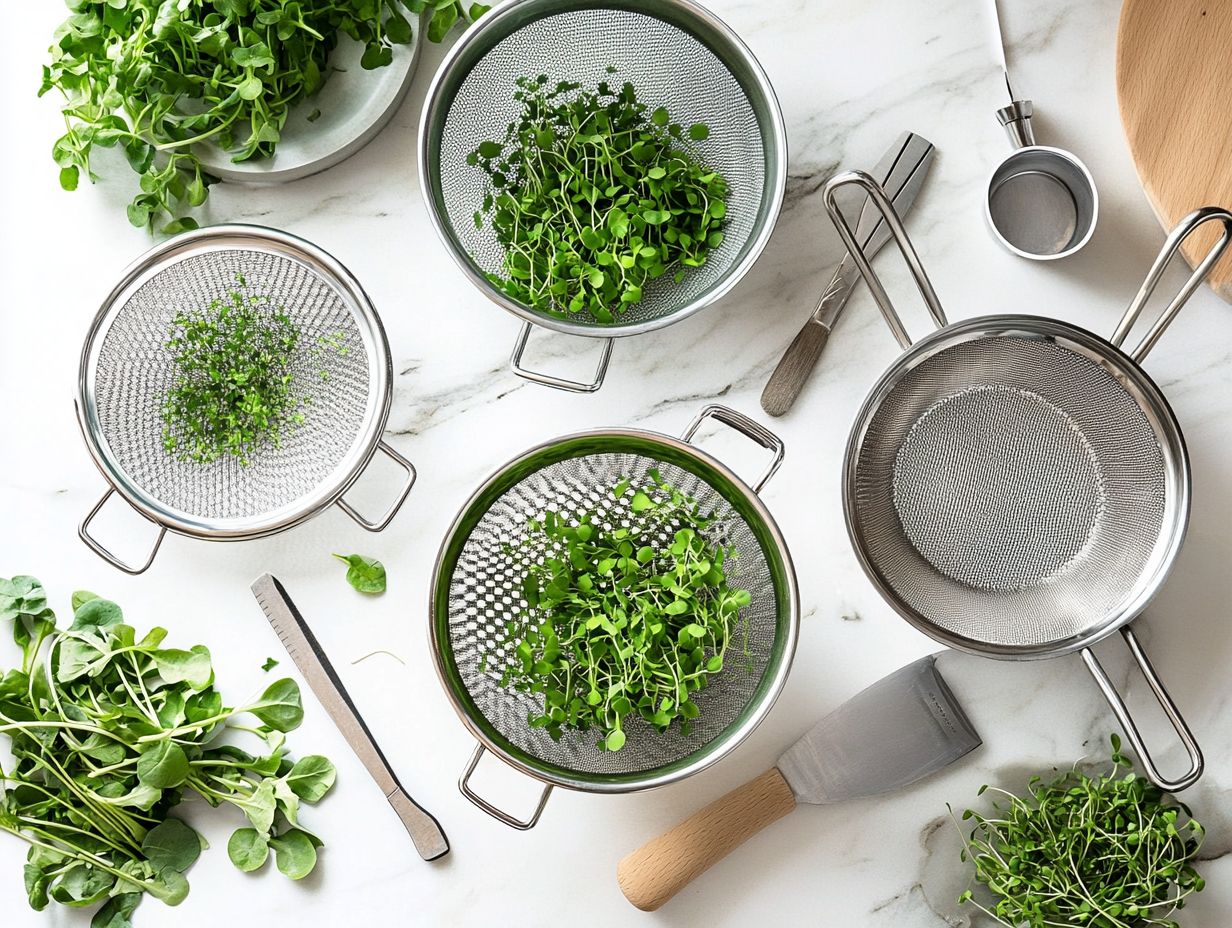
A cheesecloth strainer is an essential tool for anyone involved in kitchen gardening. It expertly filters microgreens while allowing you to keep an eye on light exposure and moisture levels during the germination process.
This versatile gadget makes rinsing and soaking seeds a breeze. It also ensures they receive the proper air circulation as they begin to sprout.
When you immerse seeds in water and strain them with cheesecloth, you eliminate any unwanted debris and promote even moisture distribution.
Maintain optimal light conditions by placing the strainer in a location with filtered light to encourage robust growth and prevent your seedlings from becoming leggy.
Combining a cheesecloth strainer with mindful light management can lead to a more vibrant and bountiful microgreens harvest.
5. Nut Milk Bag Strainer
Nut milk bag strainers are game-changing tools for cultivating microgreens. They make soaking and rinsing seeds easy, ensuring optimal germination rates and enhancing flavor profiles.
With their finely woven mesh, these strainers prevent seed loss while guaranteeing that each seed receives thorough hydration. This is essential for sprouting.
Employing a nut milk bag allows you to evenly distribute moisture throughout your growing medium. This creates the perfect environment for seed germination.
Indoor gardeners will love how this tool streamlines their microgreens preparation. It maintains consistent moisture levels for healthier plants that flourish.
Utilizing nut milk bag strainers boosts seed viability and encourages vibrant growth, setting the stage for a flourishing indoor garden.
What Are Microgreens and Why Do They Need to Be Strained?
Microgreens are young, edible plants harvested at an early growth stage. They are brimming with nutrients and health benefits, making them a favorite among home gardeners and culinary enthusiasts.
These vibrant greens, typically plucked just after their first true leaves emerge, boast an impressive nutritional profile. They often contain higher concentrations of vitamins, minerals, and antioxidants compared to their mature counterparts.
To nurture microgreens to their full potential, provide well-draining soil, adequate moisture, and bright, indirect sunlight. These conditions foster healthy growth.
With a variety of microgreen types available, from peppery arugula and zesty radish to aromatic basil and earthy beet greens, you can explore distinct flavors and culinary versatility.
Strain your microgreens to eliminate excess moisture, preventing spoilage and keeping them fresh for your salads, sandwiches, and gourmet creations.
What Are the Different Types of Microgreen Strainers?
You ll find a variety of microgreen strainers designed for specific tasks within the microgreen cultivation process. Options like stainless steel, fine mesh, nylon mesh, cheesecloth, and nut milk bags each bring unique advantages.
Each type of strainer enhances your microgreen gardening experience. For example, stainless steel strainers are robust and easy to clean, allowing for quick rinsing. Fine mesh strainers catch even the tiniest seeds or debris, ensuring a smooth, refined end product. To further improve your microgreen cultivation, consider using the best containers for microgreen cultivation.
Nylon mesh strainers are flexible and lightweight, making them user-friendly. Cheesecloth is your go-to for straining larger batches, while nut milk bags provide versatility for both straining and storing your microgreens.
Incorporating these strainers into your process elevates efficiency and helps cultivate a healthier crop.
How Do You Choose the Right Microgreen Strainer?
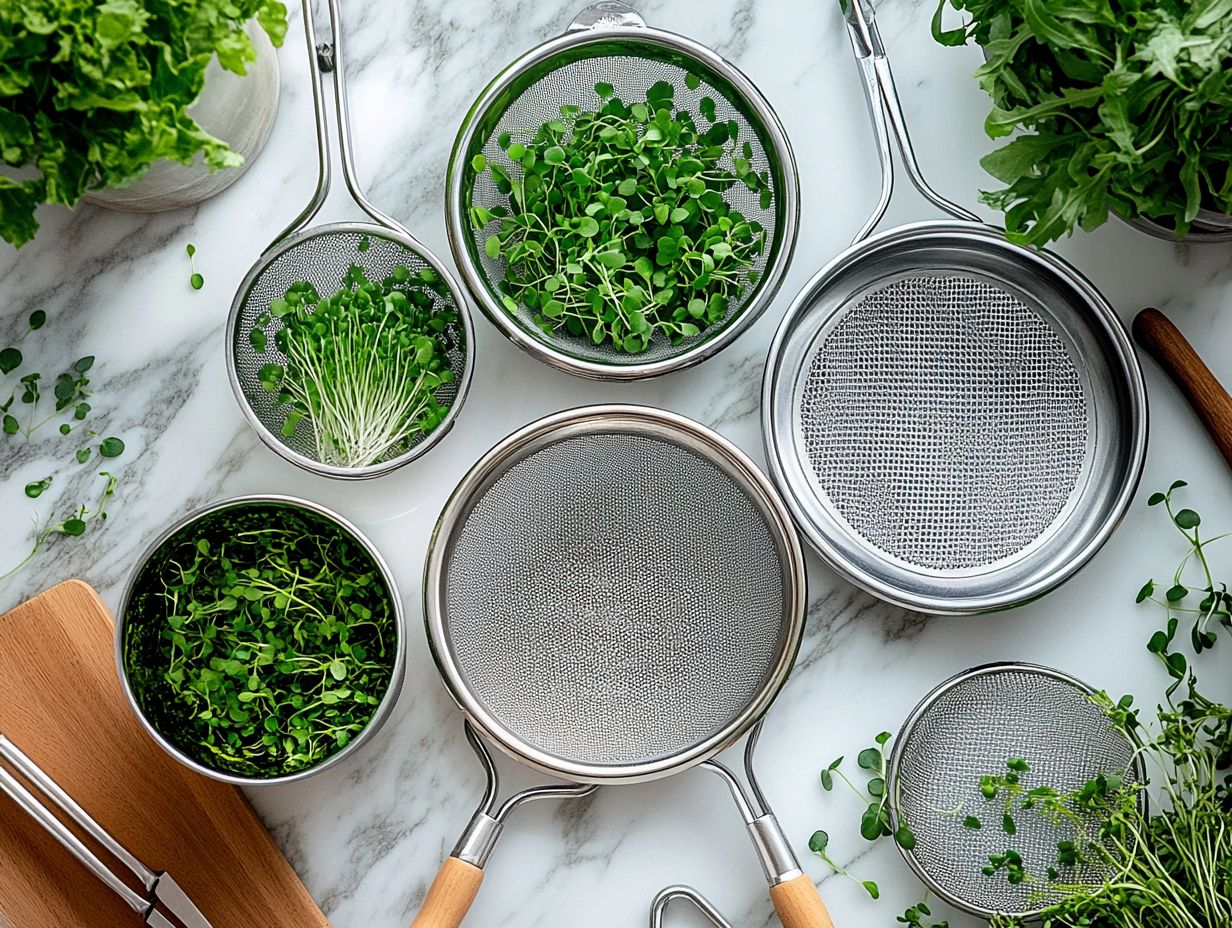
Choosing the right microgreen strainer is crucial for optimal results in your home garden. Consider factors like durability, ease of use, and the types of microgreens you re cultivating.
When selecting a strainer, assess its material. Some options provide better filtration and greater resistance to wear over time, while others are designed to be lightweight and portable.
The size of the strainer can impact how efficiently you rinse and drain your microgreens. A larger strainer can handle bulkier varieties, while smaller designs are perfect for delicate shoots.
Don t overlook design features, such as handle grips and drainage capabilities. These elements can greatly enhance your gardening experience and ensure your microgreens flourish.
What Are the Benefits of Using a Microgreen Strainer?
Using a microgreen strainer offers many benefits, from improved flavor retention to enhanced nutrition, all while making your harvesting experience more efficient.
This essential tool simplifies the harvesting process by helping you separate delicate greens from excess soil and debris. It also ensures that your microgreens retain their vibrant colors and concentrated flavors.
With a microgreen strainer in hand, you ll enjoy a much smoother washing procedure, dramatically reducing the time you spend on preparation.
The enhanced nutritional value, combined with ease of rinsing off contaminants, leads to a healthier and more flavorful outcome. These advantages make your gardening experience more enjoyable, perfect for both seasoned gardeners and enthusiastic beginners.
What Are the Common Mistakes When Using a Microgreen Strainer?
Many gardeners face common pitfalls when using a microgreen strainer, such as improper rinsing techniques, neglecting seed soaking, and failing to monitor moisture levels, all of which can compromise your final yield.
To cultivate a flourishing microgreen crop, begin with a meticulous rinse to eliminate debris or potential pathogens. You may underestimate the significance of soaking seeds for the recommended duration; this step activates germination and fosters healthier growth.
Actively monitor moisture levels throughout the growth cycle to prevent problems like mold or wilting. Establish a consistent watering schedule and employ a gentle spray technique to keep the soil adequately moist without becoming waterlogged.
By focusing on these essential details, you can greatly elevate your microgreen cultivation experience.
How Can You Properly Clean and Maintain Your Microgreen Strainer?
Proper cleaning and maintenance of your microgreen strainer are essential for extending its lifespan and ensuring optimal performance. This is especially important for preserving the health benefits of your microgreens.
Don t let neglect ruin your strainer! A buildup of organic residue can happen quickly, compromising the quality of your produce and introducing harmful contaminants into your garden.
To effectively clean different types of strainers, begin by disassembling the equipment and rinsing it under warm water to dislodge any remaining debris. For finer mesh strainers or those with delicate components, a soft brush can gently remove stubborn particles without causing damage.
After rinsing, use a mild solution of vinegar and water to sanitize the parts and prevent corrosion. For ongoing maintenance, make it a habit to routinely inspect your strainers for signs of wear. Keep all components dry and store them in a clean, dust-free environment to protect against contamination.
Frequently Asked Questions
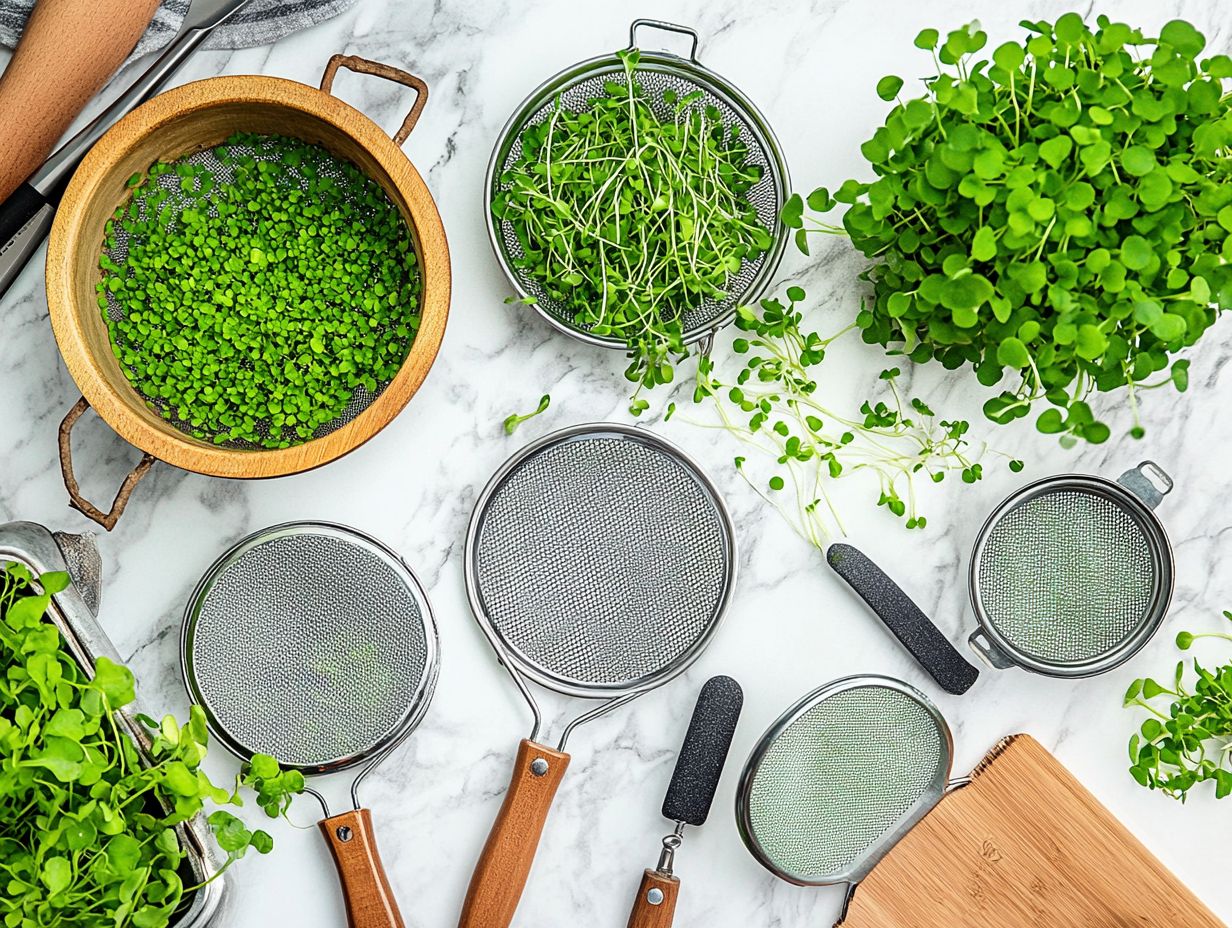
What are the top 5 microgreen strainers on the market?
Discover the top five microgreen strainers available today: SunGrow, UrbanLeaf, Botanical Interests, Hamama, and Chef’n.
What makes the SunGrow microgreen strainer stand out from the rest?
The SunGrow microgreen strainer has a unique triple-layered design for efficient water drainage. This prevents mold growth while ensuring easy storage with its non-slip base and lid.
Which microgreen strainer is best for beginners?
The Hamama microgreen strainer is perfect for beginners. It comes with a starter kit that has everything you need to grow microgreens at home. Get started today and enjoy fresh microgreens from your kitchen!
Can I use the UrbanLeaf microgreen strainer for other purposes?
Absolutely! The UrbanLeaf microgreen strainer doubles as a sprouting lid for mason jars or a colander for washing fruits and vegetables.
Are all microgreen strainers dishwasher safe?
No, not all strainers are dishwasher safe. Always check the product specifications to avoid damage.
What is the Botanical Interests microgreen strainer made of?
You ll love that this strainer is made of safe, food-grade plastic. It s BPA-free, durable, and a great investment for avid microgreen growers!



